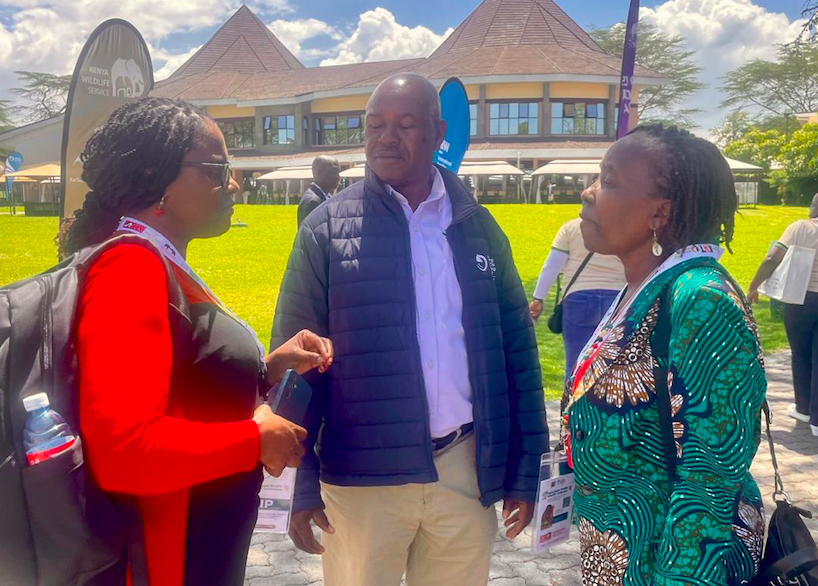
 Africa Wildlife Foundation Country Director Nancy Githaiga, Wildlife Research Institute board chairman Dr David Nkedianye and African Conservation Centre Executive Director Lucy Waruingi consult during the second international wildlife scientific conference./HNADOUT
Africa Wildlife Foundation Country Director Nancy Githaiga, Wildlife Research Institute board chairman Dr David Nkedianye and African Conservation Centre Executive Director Lucy Waruingi consult during the second international wildlife scientific conference./HNADOUTScientists have raised an alarm over the loss of wildlife
corridors and dispersal areas, warning that the move could wipe out iconic
species.
Mohamed Said from the African Elephant Specialist Group, who
made the presentation on wildlife population dynamics, said the lost corridors
and dispersal areas will have devastating impacts on the wildlife population.
“Land fragmentation, subdivision, unregulated settlement,
incompatible land uses and fencing threaten to collapse wildlife migration,” he
said.
Said made the remarks
at the Second International Wildlife Scientific Conference at Lake Naivasha
Resort.
The Wildlife Research
and Training Institute convened the conference, which builds on the success of
the inaugural conference held in September 2023, which attracted more than 300
participants and featured 127 scientific papers presented by both local and
international researchers.
This year’s conference theme is: “Innovations in Wildlife
Conservation Science and Practice for Socioeconomic Development.”
Researchers, conservation practitioners, policymakers, community leaders and international partners meet to exchange knowledge, present cutting-edge scientific findings and deliberate on solutions for sustainable biodiversity conservation and human development.
Private land fencing increasingly restricts wildlife.
To demonstrate his point, Said used a number of studies that
have been conducted.
The studies show how some of the wildlife migrations have
been impacted by land fragmentation, fences and mining.
One of the studies titled Nairobi Alternative Futures shows wildebeest
migration around Athi Kapiti collapsed due to challenges that faced the
ecosystem, such as fences.
The blocked corridors have also been a source of conflicts
between humans and wildlife.
Said said the ongoing urban development along the Athi
Kapiti does not augur well with wildlife migration.
In the Tsavo Ecosystem, mining threatens wildlife dispersal
areas and migratory corridors where there is a conflict between mining and
conservation in the ecosystem.
He said the fencing in Mara has impacted on migration of
wildlife.
Said said due to challenges they experience, wildebeest now
spend only 35 days at Maasai Mara. “We are losing a lot of money due to this.”
The annual spectacle, often dubbed the "Eighth Wonder
of the World", draws thousands of tourists to Kenya every year and is a
major highlight on the global tourism calendar.
Said lauded the ongoing efforts at the Amboseli ecosystem to develop management plans.
He said there is a need to scale up to other ecosystems.
About 1.4 million wildebeest— accompanied by about 200,000
zebras, 400,000 gazelles and 12,000 eland— cover up to 3,000km every year in a
cycle that follows seasonal rainfall patterns.
This migration is now threatened by plans for new roads and
railways, uncontrolled and unplanned developments and exponential human
population growth around the edges of the Serengeti-Mara ecosystem.
Studies have shown that the disruption to the migratory route
has genetic implications for the animals’ longer-term survival.
The studies also show that wildebeest populations that no
longer migrate are less genetically healthy than those that continue to
migrate.
Wildlife move for
various reasons.
Some migrate to look for food and water, avoid harsh weather
conditions, when their habitat is overcrowded and to find a safe place to give
birth or lay eggs.
African Conservation Centre executive director Lucy Waruingi
said there is a need to have an action plan to implement the report that was
done in 2015.
Waruingi said the report identified 90 important corridors.
A corridor means an area that provides connectivity between
one important conservation area and another, and allows for the mobility of
wildlife between the two areas.
The main purpose is
to support the availability of habitats in different seasons, so that livestock
and wildlife migrate from one area to another based on the availability of
habitats as they move.
Waruingi said a rapid assessment of some of the corridors is
already blocked because the development that has happened is incompatible with
conservation.
“Others are highly threatened. A few success stories, some
are secure, especially with the growth of conservancies. But it is not enough
to identify and map and give a report on the status of corridors.”
Waruingi said it's critical to implement the provisions of
the report.
“Kenya needs to have a clear action plan to implement the
corridor report, which will begin with assessing the status of all of them.”
Waruingi said there is a need to ensure that communities benefit from protecting corridors.
She said there is a need to have laws that help define the corridors geographically and define the provisions of how it will be managed.













